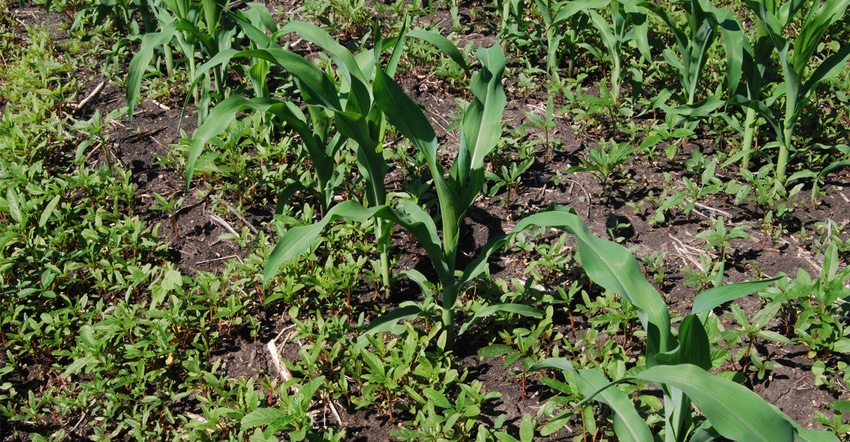June 17, 2019

While good progress has been made getting crops in the ground during the first two weeks of June, the prolonged adverse conditions earlier this spring are likely to complicate weed management throughout the 2019 growing season.
The unusually wet spring and delayed corn and soybean planting has complicated the weed control plans for many farmers. The most important step in minimizing problems is to scout fields regularly to identify weed problems quickly. That will allow you to make timely and effective adjustments to your weed management strategy.
Bob Hartzler, Iowa State University Extension weed management specialist, and field agronomist Meaghan Anderson offer the following observations and tips to help farmers stay on top of weed control this year.
Performance of preemergence programs
Herbicide products used in fields planted in a “timely fashion” are likely to have a shortened residual activity due to abundant rain this spring. That increases the importance of making timely postemergence applications.
A different issue will be encountered in fields that were planted during the last week of May and first two weeks of June. These fields were planted during peak periods of weed emergence, and many areas of Iowa went for more than a week without rain needed to activate preemergence herbicides. Many of these fields will require a postemergence herbicide treatment several weeks earlier than normal.
Crop development on weed control
A full crop canopy is a critical component of successful weed management. The warmer weather and accumulation of growing degree days during the first week or so of June helped move corn forward. But the slow development of crops throughout May, along with early degradation of preemergence herbicides, will make achieving full-season weed control more difficult this year than in most years.
Delayed soybean planting is also likely to complicate weed management. Many fields were planted under less-than-ideal conditions that may result in uneven stands, creating gaps in the crop canopy. Soybeans planted in 30-inch row width may not form a full canopy, further favoring the survival of late-emerging weeds. The delayed or hindered crop canopy development will make timely application of an effective postemergence program more important than in most years.
The application window for many post-herbicide products will be reduced due to the crop advancing through growth stages more quickly than it would with normal planting dates. Flower development on soybean plants will still occur in the latter part of June for most fields, even many late-planted ones.
Keep in mind that dicamba products registered for Xtend soybean varieties must be applied prior to the R1 stage of soybean plants (that is before the first flowers appear). Liberty (LibertyLink) has the same restriction (it can be applied up to R1 growth stage of soybeans), whereas glyphosate (Roundup Ready) or 2,4-D (Enlist) can be applied through the R2 stage.
Performance of post programs
While growers have reduced their reliance on postemergence products due to widespread herbicide resistance, post products will be more important this year due to the environmental factors influencing the performance of preemergence herbicides. The best way to reduce risks is to scout fields earlier than would be typical, spray when weeds are smaller than label limits, and include a residual herbicide with the postemergence program to extend weed control later into the season.
Waiting until weeds reach the maximum controllable size to begin post applications and failing to include a residual herbicide will result in a greater risk of control failures, more weed survival and seed production, and greater opportunity for new resistance issues.
Herbicide carryover
The potential for herbicides to affect rotation crops or cover crops is influenced by many factors. While herbicide half-life and rainfall throughout the growing season are the most important factors, application date also plays a role. Delayed application results in the herbicide being applied closer to the establishment of the following crop, and in some cases, leading to problems with herbicide carryover.
Check the rotational restrictions on product labels to ensure the herbicide won’t affect plans for rotational crops you plan to plant this fall or next spring. Herbicides that can have increased carryover risk when applied in a late application include fomesafen, imazethapyr and chlorimuron.
The impact of this spring’s prolonged cool and wet weather on weed control is not over. Weed management programs in many fields will need to be adjusted from what was planned to avoid costly control failures. Early scouting of fields is essential to determine how well preemergence programs are working and allow timely adjustments to the postemergence program.
Reach out to your local ISU Extension field agronomist if you have questions about managing weeds this year.
Source: ISU, which is responsible for the information provided and is wholly owned by the source. Informa Business Media and its subsidiaries aren’t responsible for any of the content in this information asset.
You May Also Like




